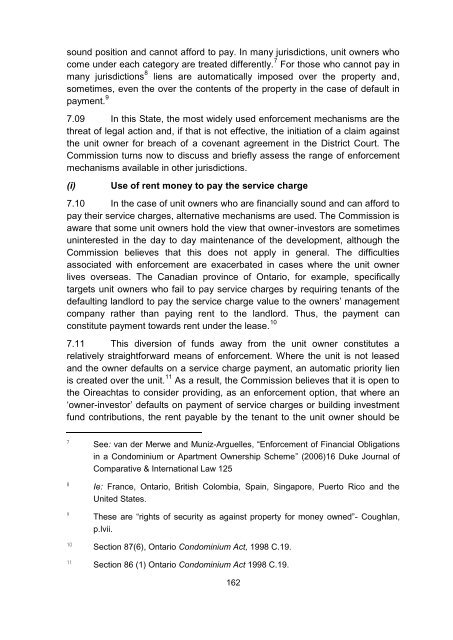Report on Multi-Unit Developments - Law Reform Commission
Report on Multi-Unit Developments - Law Reform Commission
Report on Multi-Unit Developments - Law Reform Commission
Create successful ePaper yourself
Turn your PDF publications into a flip-book with our unique Google optimized e-Paper software.
sound positi<strong>on</strong> and cannot afford to pay. In many jurisdicti<strong>on</strong>s, unit owners who<br />
come under each category are treated differently. 7 For those who cannot pay in<br />
many jurisdicti<strong>on</strong>s 8 liens are automatically imposed over the property and,<br />
sometimes, even the over the c<strong>on</strong>tents of the property in the case of default in<br />
payment. 9<br />
7.09 In this State, the most widely used enforcement mechanisms are the<br />
threat of legal acti<strong>on</strong> and, if that is not effective, the initiati<strong>on</strong> of a claim against<br />
the unit owner for breach of a covenant agreement in the District Court. The<br />
Commissi<strong>on</strong> turns now to discuss and briefly assess the range of enforcement<br />
mechanisms available in other jurisdicti<strong>on</strong>s.<br />
(i)<br />
Use of rent m<strong>on</strong>ey to pay the service charge<br />
7.10 In the case of unit owners who are financially sound and can afford to<br />
pay their service charges, alternative mechanisms are used. The Commissi<strong>on</strong> is<br />
aware that some unit owners hold the view that owner-investors are sometimes<br />
uninterested in the day to day maintenance of the development, although the<br />
Commissi<strong>on</strong> believes that this does not apply in general. The difficulties<br />
associated with enforcement are exacerbated in cases where the unit owner<br />
lives overseas. The Canadian province of Ontario, for example, specifically<br />
targets unit owners who fail to pay service charges by requiring tenants of the<br />
defaulting landlord to pay the service charge value to the owners‘ management<br />
company rather than paying rent to the landlord. Thus, the payment can<br />
c<strong>on</strong>stitute payment towards rent under the lease. 10<br />
7.11 This diversi<strong>on</strong> of funds away from the unit owner c<strong>on</strong>stitutes a<br />
relatively straightforward means of enforcement. Where the unit is not leased<br />
and the owner defaults <strong>on</strong> a service charge payment, an automatic priority lien<br />
is created over the unit. 11 As a result, the Commissi<strong>on</strong> believes that it is open to<br />
the Oireachtas to c<strong>on</strong>sider providing, as an enforcement opti<strong>on</strong>, that where an<br />
‗owner-investor‘ defaults <strong>on</strong> payment of service charges or building investment<br />
fund c<strong>on</strong>tributi<strong>on</strong>s, the rent payable by the tenant to the unit owner should be<br />
7<br />
See: van der Merwe and Muniz-Arguelles, ―Enforcement of Financial Obligati<strong>on</strong>s<br />
in a C<strong>on</strong>dominium or Apartment Ownership Scheme‖ (2006)16 Duke Journal of<br />
Comparative & Internati<strong>on</strong>al <strong>Law</strong> 125<br />
8<br />
Ie: France, Ontario, British Colombia, Spain, Singapore, Puerto Rico and the<br />
<strong>Unit</strong>ed States.<br />
9<br />
These are ―rights of security as against property for m<strong>on</strong>ey owned‖- Coughlan,<br />
p.lvii.<br />
10<br />
Secti<strong>on</strong> 87(6), Ontario C<strong>on</strong>dominium Act, 1998 C.19.<br />
11<br />
Secti<strong>on</strong> 86 (1) Ontario C<strong>on</strong>dominium Act 1998 C.19.<br />
162

















